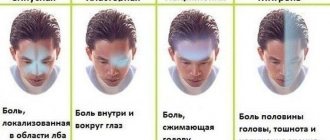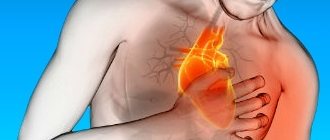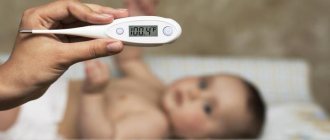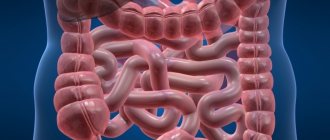Persistent headaches in the eyes and forehead are a common symptom that affects many men and women between the ages of 20 and 60. Cephalgia can occur for various reasons; it can be provoked by various factors (dangerous to human health and non-dangerous).
You can determine exactly why your head hurts in the forehead and eyes after undergoing a full examination. It is necessary to be examined if cephalalgia is constant or if it occurs periodically.
For frequent pain, after diagnosis, appropriate treatment is almost always prescribed. Traditional medicine in this case is unlikely to be able to effectively help, because usually headaches in the forehead and eyes are only a symptom of some disease that requires specialized treatment.
Main reasons
As already mentioned, the development of cephalalgia can occur for a variety of reasons. The most relevant of them today are:
- Psycho-emotional or physical stress. Many people suffer from headaches that occur during severe emotional stress (stress, anxiety, depression), or physical fatigue. The pain syndrome in this case can be of varying duration (depending on the general condition of the person). Usually it subsides some time after the provoking factor is eliminated (during moral and physical rest). In this case, no special treatment is required. The main thing is to avoid stress and excessive loads.
- High intracranial pressure. If you experience a severe headache in the forehead in the evening or in the morning, this may indicate the presence of certain disorders in the functioning of the vascular system of the brain and eye sockets. Intracranial pressure can increase as a result of weather changes, under the influence of stress, in the presence of certain diseases of the heart, brain structures and other organs. With constant increased intracranial pressure, the risk of stroke increases (relevant for people of retirement age). Headaches of this type usually do not go away on their own, so the sick person needs a high-quality examination and medical care.
- Migraine. If a person has a systematic headache in the forehead and eyes, radiating to the temples and other areas of the head and skull, then there is a high probability that these are migraine pains. In case of periodic occurrence of migraine, a full examination is required, which will help to identify the root causes of this pathology. You can recognize a migraine yourself by the accompanying symptoms that may occur with pain: the urge to vomit, mild or severe nausea, numbness and noticeable tingling in the limbs.
- Hematomas, tumor growths in brain structures. Hematomas develop after injury to the brain or skull, concussion (from a fall, blow, etc.). Here, much will depend on the nature of the injury and its severity. In the case of a mild concussion and the formation of a small hematoma, headaches are the main consequence of the injury. If, in addition to pain, there are other symptoms (nausea, vomiting, deterioration of hearing, vision, systematic fainting, etc.), then this may indicate the presence of serious damage to certain parts of the brain.
- Vascular aneurysm. Headaches that occur against the background of a cerebral aneurysm are very characteristic: they will always be accompanied by pulsating sensations radiating to the eyes. When turning, bending or any other head movements, the pain will intensify. Mandatory examination and treatment of the underlying disease is required (simply eliminating headaches with painkillers is not the right solution). The pain associated with an aneurysm usually intensifies with pressure on the head.
- Inflammatory process in brain structures. Inflammation in the brain in adults and children can be caused by various diseases (most often encephalitis, meningitis and other viral pathologies). In particular, with meningitis, patients will almost always have a headache and the area of the left eye (less often the right) will pulsate. Pain often radiates to the cervical region (if the inflammatory process is advanced). The patient may vomit frequently
- Sinusitis, sinusitis, ARVI and other respiratory diseases. Headaches in the forehead and eyes in this case are only a symptom. Symptoms are also expressed: high temperature, increased mucus secretion, breathing problems, stuffy throat (this can last for a long time).
- Menstruation, pregnancy. During menstruation and pregnancy, many women experience headaches localized in different parts of the head (frontal, temporal, parietal areas, etc.). Usually the pain syndrome is not expressed, but intensifies with sudden tension.
Headaches in the forehead, temples and eyes also often occur with diseases of the trigeminal nerve, with inflammation that forms in the mouth and nose, and with severe allergic reactions.
The reasons listed above can be combined with each other. Pain that occurs in the area of the forehead and eyes often appears not only against the background of various disorders, but also due to banal overwork, do not forget about this. In cases where the head hurts during rest, before bed, in the morning and at other times when there was no moral or physical fatigue, then this is a reason to visit a doctor.
For persistent headaches in the forehead and eyes, it is recommended to take into account other symptoms that will indicate the presence of various pathologies:
- Osteochondrosis. If osteochondrosis develops in the neck area (cervical spine), it can lead to serious disorders. During the development of this pathology, characteristic symptoms are observed: dizziness, a feeling of pressure on the eyes, pain in the frontal regions. Patients may feel nauseous, they also experience numbness in the extremities, lightheadedness, problems with vision and hearing, impaired blinking, and high blood pressure.
- Overwork. Diagnosing normal fatigue in a person is not difficult. Characteristic symptoms: pain in the frontal part (less often in the eyes), eye strain, tearfulness, a feeling of heaviness in the eye sockets. Partial impairment of concentration and memory is possible. In such cases, doctors recommend having a good rest (optimally in the fresh air) and taking any sedative pills.
- VSD (vegetative-vascular dystonia). Headaches with VSD are observed quite often, although they are not a pronounced symptom of this pathology.
The presence of headaches in the forehead and front of the head is also recorded in fairly serious diseases: oncological tumors in the brain structures, an inflammatory process in the vascular system of the brain, Horton's syndrome, trigeminal neuralgia.
Self-help for pain
- You can take antispasmodic drugs to eliminate symptoms.
- A loved one can massage the head, neck and back to perfectly relieve tension and eliminate unpleasant painful sensations.
- A cold compress on the forehead helps relieve pain and reduces pressure on the temples
- A walk in the fresh air, as well as a good night's sleep, can relieve you of problems with pain in your temples.
- If you know you have hypotension (low blood pressure), you can drink strong tea or coffee.
It is recommended to use medications only if other methods do not help or the patient is away from home and does not have the opportunity to rest and relax. Medicines affect each person differently. You should choose what will help you.
- A universal and effective remedy is paracetamol.
Be careful not to take medications in large doses.
Migraine and hypertension
Many doctors, having heard complaints of headaches radiating to the eyes and eyebrows, most often begin to suspect the presence of hypertension or high blood pressure. This pathology can manifest itself at almost any age (even in a child during puberty). Pain syndrome localized in the eye area, in this case, is provoked by an increase in pressure directly inside the eyeball. Hypertension often develops against the background of severe fatigue and overwork.
It is known that migraine headaches develop and are localized on the right or left in the temporal zone. In this case, the pain almost always radiates to the eyes.
Factors that provoke the appearance of high blood pressure and migraines are:
- Bad habits (experienced alcoholics and simple drinkers often suffer from headaches in the forehead and eyes).
- Abuse of energy drinks and caffeine (energy drinks should be avoided completely, and caffeine consumption should be seriously limited so that the pain syndrome goes away).
- Excessive salt consumption (in the absence of bad habits, headaches often develop due to the large amount of salt consumed; it is highly advisable to monitor this, especially in adulthood).
- Taking certain medications (many potent medications have a line about headaches and dizziness in their list of side effects).
- Problems with sleep and wakefulness (many people, regardless of age, experience constant headaches if their sleep patterns are disturbed).
- Excessive and infrequent physical activity (if you overexert yourself from a physical point of view once a week, you will not be able to avoid headaches immediately afterwards).
- A sedentary lifestyle (constant presence at the computer, in front of the TV, poor physical activity - all this leads to certain disorders and diseases, which are manifested in part by headaches).
- Changes in weather (some people are extremely sensitive to weather changes, in which headaches are one of the main symptoms).
If the pain in the head and eyes is localized on one side and has a rather pronounced, pulsating character, then there is a high probability that it is a migraine.
With a migraine, the pain syndrome can be so severe that a person will not even be able to sleep normally unless he takes special painkillers.
They cannot be predicted in advance
The cause of pressing pain in the temples can be a variety of life factors, sometimes beyond our control, therefore unpredictable and uncontrollable. And they do not always result from some serious pathology. For example:
- Changes in weather conditions: changes in atmospheric pressure, changes in weather conditions (suddenly a strong wind rose, which blows for a day, or two, or more, humidity and air temperature went up or down) - weather-dependent people feel all this very well. Many of them probably already have a history of such a symptom complex (it is not particularly considered a disease) such as. And throughout the entire period of turbulent natural phenomena, these people feel a headache, which puts pressure on the temples and eyes, discomfort may appear in the occipital region and other symptoms may develop (changes in blood pressure, nausea, noise effects);
- Great physical stress associated with heavy lifting or frequent head tilting will after some time result in pressing pain in the temples;
- Stressful situations and psycho-emotional stress can provoke pressure in the temporal parts and occipital region, create discomfort in the eyes, and also cause nausea and a gag reflex;
- Pressing pain in the temples can occur during periods of both short and long fasting;
- Gives similar symptoms and mental stress. Troubles, when an unknown force presses on the temples and eyes, often haunt students during exams, most of all those diagnosed with vegetative-vascular dystonia;
- Similar phenomena occur from time to time in people whose profession is associated, for example, with a microscope or computer. Of course, this does not happen all the time, otherwise a person simply would not be able to work in this place, and the work regulations stipulate taking 15-minute breaks every hour. However, anything can happen (what if it’s an emergency?), and a person, with the goal of absolutely completing the task, is forced to ignore the instructions, and then after a few hours of intense activity he will probably feel his temples hurt and pressure on his eyes. The same type of pain is observed in jewelers, assemblers (on the assembly line), and drivers;
- Traveling in transport (engine noise, the sound of train wheels, stuffiness in the cabin of a car or carriage). Especially, people suffering from certain pathologies are sensitive to flights. Not only does the airliner itself rise to a high altitude, causing a change in blood pressure in such passengers, but passengers, while traveling, end up from one climate zone to another. As for water transport, everyone knows (some have experienced it, some have just heard) “seasickness”. True, here there is no pressure on the temples and nausea, but simply nausea, vomiting and dizziness. Headache from motion sickness is extremely rare;
- A long stay in a stuffy room, in the sun (relaxing on the beach, working in the field, which, in addition, is associated with frequent bowing of the head) can lead to the fact that in the evening a person will tell how his temples hurt and there is pressure on his eyes;
- Functional disorders of the endocrine system due to physiological conditions leading to hormonal changes (puberty, pregnancy, lactation, menopause) are transient conditions, so pressing pain in the temples and painful sensations in other localizations may disappear over time, which means the disease will also disappear;
- In some circumstances, it is difficult to draw the line between accident and pathology (we will classify it as unforeseen events), but various types of poisoning (food, alcohol, nicotine, medicinal, etc.) respond to pressing pain in the temples. The most common cause of such symptoms is intoxication with tobacco smoke and alcoholic beverages, especially low-quality ones (heavy smokers and people prone to alcohol abuse know how in the morning, after “too much”), there is pressure on the temples and nausea.
In other cases, the intervention of various diseases can be traced, sometimes quite serious, requiring long and persistent treatment, which, unfortunately, does not always lead to success.
Pregnancy
During pregnancy, many women suffer from migraine headaches. This disease is neurological and usually begins to develop at a young age. It can be characterized by the occurrence of repeated attacks of pain in the head, problems with the gastrointestinal tract and vision.
If a woman suffered from migraines before pregnancy, then during pregnancy the disease will most likely begin to manifest itself again, because its appearance can be provoked by various factors:
- Nutritional (hunger, consumption of foods containing phenyls and tyramine, excessive consumption of red wine, citrus fruits, confectionery products).
- Physical irritants (flashing lights, unpleasant odors, sharp noises, etc.).
- Stressful situations.
- Changes in weather, trip to a different climate zone.
- Fatigue, chronic sleep problems.
- The presence of concomitant chronic diseases, their exacerbation during pregnancy.
Many pregnant women who have reduced immunity are exposed to drafts during pregnancy, so they catch ARVI and other colds.
According to statistics, headaches most often occur in the first half of pregnancy, while in the second half they practically disappear. Scientists explain this by a change in hormonal levels, a decrease in fluctuations in hormone levels in the blood.
In addition to migraines, pregnant women often experience tension headaches, which are localized specifically in the frontal and temporal lobes. This is a pain syndrome of moderate intensity, which, in addition to the frontal and temporal parts, can cover the entire head. The nature of the pain is pulling, squeezing. Painful sensations of this type are usually caused by psycho-emotional or physical stress.
Temporal pain
Temples and eyes hurt - what is the pressure?
Source: bolezniglaznet.ru Temporal headache is familiar to every second resident of our country. It torments people of all ages. Some people experience headaches in the right temple or the left, while others suffer from pain in both temples. It is worth admitting that the painful syndrome is very difficult to tolerate. A person is ready to agree to take any medicine, just to quickly stop feeling throbbing pain. There are various medication solutions to get rid of headaches.
Temporal pain is driving me crazy. Of course, such a manifestation has an impact on well-being. It is difficult for a person to relax, he cannot concentrate on anything, and his performance is significantly reduced.
The only thing that interests a person in such a situation is how to quickly get rid of a headache in his throbbing temples. There can be no question of any rest in such a situation.
Headache can be caused by various reasons. The pain may be throbbing and pressing. Less often it is cutting. Headache, aching temporal pain, as a rule, occurs in the morning, which forces you to wake up before the alarm clock.
In general, attacks of pain are not “warned” when they occur. Everything happens quickly and unexpectedly. Under no circumstances should you delay visiting a doctor if headaches in your temples intensify and occur with some certain frequency.
At a minimum, you should contact a therapist, and he will refer you to a specialist. What is the nature of headaches in the temples? In fact, the causes of a painful syndrome that occurs in the head can be very different. This requires a wide range of studies.
The most common cause of headaches in both temples is a pressure difference. Plus, attacks can occur due to some kind of disease. There are more than fifty main causes that can cause headaches in the temples.
Here are the most popular causes of headaches in the temples:
- Disruption of the circulatory system (namely the brain). Doctors note that pain occurs with a sharp increase in indicators. Often pain occurs due to wear and tear of the blood vessels and loss of their elasticity. In this case, long-term treatment is required.
- Viruses, bacteria. As soon as you get sick with sinusitis, flu, colds, meningitis, a headache appears in your temples. How to get rid of it? You need to undergo treatment for a viral or bacterial disease and the problem will be solved.
- Changes in the body associated with age. Over the years, the blood vessels of the brain become significantly depleted, and blood passes through them with difficulty. This can cause severe headache pain in the temples.
- Intoxication. By eating low-quality foods, drinking alcohol, smoking cigarettes, and abusing spices, you can poison your own body. Intoxication, in fact, is one of the most popular reasons that cause headaches in the temples.
- Pinched trigeminal nerve. This occurs due to spinal injury, as well as after the development of neck disease. Often in this case, temporal headache is accompanied by noise effects.
- Hormonal imbalance. During puberty, pregnancy, breastfeeding, and menopause, disturbances in the hormonal system may occur. They cause headaches in the temples. In this case, you also need to consult a good specialist.
- Toothache. It is worth noting that absolutely any pain that is felt in the facial area can provoke the appearance of temporal pain. Headache, or rather its true cause, is more difficult to diagnose.
- Overstrain of the body. The crazy rhythm makes modern people run about their business, not paying attention to their own overwork. But it is precisely this that can cause severe attacks of headaches in your temples.
As everyone understands, the causes of temporal headaches are very individual. And this means that in no case should you resort to the recommendations of acquaintances and friends who also once had an attack of temporal headache.
It is extremely important to determine the real cause of the pain. And only then, after consulting with a knowledgeable doctor, you can start taking certain medications. Please note that different courses of treatment may be prescribed for different people with the same causes.
Any headache in the temples is characterized by suddenness and sharpness. In the event that the painful syndrome arose against the background of overwork, experienced strong emotional turmoil, the duration of the temporal headache can be 30 minutes, or can last the whole day.
If a headache appears in the pulsating temples in the morning, most likely it is caused by a malfunction of the blood vessels. This pain is accompanied by general weakness, tinnitus, and nausea.
Of course, we should not exclude the possibility that pain may arise due to poor circulation due to sleeping in an uncomfortable position. That is, if a painful attack goes away on its own after some time, you should know that there is no reason for serious concern, but you should think about changing your pillow or mattress.
Important
These manipulations will not help in the fight against chronic morning pain in the head. You'll have to see a doctor. When pain occurs against the background of a previous injury, the symptoms can be very different: pulsation in the temples, movement of the source of pain from the temporal lobe to the occipital lobe.
In any case, the pain is very severe, and if appropriate measures are not taken, such pain can become chronic. When unpleasant sensations are present both in the temples and in the neck, and even echo in the ear, most likely, you have an inflamed nerve ending in the occipital region.
As you can see for yourself by examining the symptoms in detail, it is not difficult to guess the true cause of temporal headache, but this is not a reason to self-medicate. It is mandatory to undergo an examination, after which the doctor will be able to make a diagnosis and prescribe appropriate treatment.
If you want to help your doctor make a diagnosis, we recommend keeping a diary in which you will note the number and nature of headaches. This is important for those who suffer from the disease not occasionally, but constantly.
Thanks to your notes, it will be easier for a specialist to get a picture of the course of the disease. Have no doubt, a diary can really help in making the correct diagnosis. After consulting with your doctor, you can start taking medications.
These can also be sedatives that effectively relieve painful syndromes. When prescribing medications, a doctor is guided by only one idea: to offer a remedy that has fewer side effects.
There are simply no completely harmless drugs. Anyone who is overly addicted to pills should remember this. Medicines and drugs should be used only in cases of extreme necessity.
Those who especially need to limit the intake of medications are children and pregnant women, as well as nursing mothers. In any case, everyone must strictly adhere to the indicated dosage.
Get rid of headaches in the temples at home. You can try to alleviate headaches in the temples at home, without resorting to medications. Don’t think that any method will immediately help you recover.
Treatment at home is a comprehensive approach:
- Self-massage of the head. It is done simply, without outside help, it is only important to discover where the points responsible for the headache are located. Many people gain knowledge through the process of massage. It is worth admitting that self-massage is really effective. Don't neglect it. As soon as you feel a twinge of pain, immediately take a comfortable position and start massaging your head with your fingertips. It's better to start with the area that hurts the most. Then you need to go over the entire head, including the temporal, occipital, and frontal zones. When you finish the massage, remain relaxed for a few more minutes. Rest is the best of all medicines.
- Warm bath, contrast shower. What to choose? It depends on what caused your pain. Thanks to the contrast shower, you will significantly improve blood circulation, which in turn will help you get rid of headaches. A bath will relax you, which will also help relieve pain.
- Meditation. As noted above, pain can occur due to stress, overwork, and fatigue. Meditation is the best rest for the nervous system. Many people mistakenly think that meditation is difficult. In fact, anyone can learn the basics of meditation.
- Walks in the open air. It would seem that everyone knows that it is important to walk outside, but many neglect this advice. However, everyone can be convinced that pain in the temporal region goes away after 30 minutes spent in the fresh air. Walking in public gardens is the best prevention for migraines. And besides, do not forget to constantly ventilate the room.
As for the use of folk recipes and medicinal herbs, you need to understand that it is impossible to carry out such self-medication procedures without the consent of a doctor. After all, without knowing the true nature of the origin of temporal pain, you can significantly harm your health.
If you suddenly have a sudden pain in your head, just put everything aside and try to relax, you can lie down and sleep. Quality sleep will definitely benefit you. And, most likely, you will not have to resort to the use of medications.
Frequent headaches are an obvious sign that you definitely need to seek help from a specialist. A therapist or neurologist will prescribe a comprehensive medical examination of the cardiovascular and nervous system and, based on its results, make a diagnosis and prescribe appropriate gentle treatment.
As a rule, the underlying disease (cause) is treated and medications aimed at relieving temporal pain are prescribed for the period of treatment. Any doctor will tell you that it is better to prevent a disease than to treat it.
Here is a short list of preventive measures:
- maintaining a healthy lifestyle;
- refusal of alcohol, drugs, nicotine;
- eating healthy foods;
- adherence to daily routine;
- physical education, sports.
Preventive measures always give positive results if they are taken in a timely manner. But in this matter, you should follow the recommendations of specialists, especially if we are talking about complex methods. For example, acupuncture can only be done in specialized clinics.
Unprofessional exposure can cause harm to health. So, you can get rid of headaches. The main thing in this matter is to individually choose a method that suits you. And you shouldn’t self-medicate.
Otherwise, in addition to the head, you will also have to treat many organs and systems of the body. Any action and decision must be agreed with a doctor.
And remember, your success in getting rid of temple pain depends on the components of a healthy lifestyle: good sleep, healthy food, rest and sleep. And you will have to forget about bad habits.
Infectious diseases
Severe headaches in the forehead and eyes are often provoked by developing viral and infectious pathologies. Among these diseases, meningitis is considered the most dangerous, during which damage to brain tissue is observed, which necessarily leads to a person having a severe headache (and the pain can radiate to both the eyes and the back of the head). A person develops the feeling that the brain is being compressed from the inside (in fact, with the development of the inflammatory process, it is precisely the compression of the internal brain structures that occurs).
If this is the nature of the pain syndrome, then you should also monitor other symptoms that may indicate meningitis and help in making a diagnosis: dizziness, severe nausea (even on an empty stomach), vomiting. If meningitis develops and is not treated for a long time, then the patient will certainly experience an elevated body temperature, which is difficult to get rid of with the help of antipyretic medications.
The development of meningitis usually occurs against the background of hypothermia (of the whole body or just the head). Therefore, if pain in the head and other symptoms appeared precisely after hypothermia, then you should urgently consult a doctor who will prescribe certain examinations on the same day.
Diagnosis of pathology
Diagnostics includes the following research methods:
- conducting computed magnetic resonance imaging of the brain, which is a modern and most effective diagnostic method;
- tomography of the cervical spine;
- angiography using contrast agents;
- ophthalmological examination of the fundus of the eyeball.
Using brain tomography, the presence of tumors and the state of blood supply are determined. This method allows you to determine the presence of damage, for example, after suffering head injuries, trauma or concussions, as well as to identify the accumulation of fluids.
Spinal tomography is used to examine the spinal cord for the presence of tumors and predisposition to intervertebral hernia.
Angiography is also performed using the magnetic resonance method, during which contrast agents are injected into the blood. This way you can diagnose an aneurysm (thinning of the artery walls) and stenotic changes in blood vessels (areas of narrowing of blood vessels).
The ophthalmologist probably plays the main role in diagnosing headaches that give off a pressing sensation in the eyes. The ophthalmologist will quickly determine whether the patient has glaucoma, characterized by increased eye pressure, or whether the patient suffers from cataracts, a clouding of the lens. Other eye diseases are also easily diagnosed, including diseases that lead to headaches and eye pain.
If there is a headache and pressure in the temples, then it is necessary to undergo a series of laboratory and instrumental studies. The most informative among them are magnetic resonance and computed tomography of the head, as well as angiography of the vessels of the brain and the feeding eyes. An ophthalmoscopy is performed with visualization of the fundus and a general and biochemical blood test is also taken.
Which doctor should I contact? If a person has pain in his temples and eyes, the first thing he should do is visit a therapist. After listening to the patient’s complaints and examining him, the doctor will prescribe treatment or refer him to another specialist: a neurologist or ophthalmologist. Additionally, the following types of examination are prescribed:
- Magnetic resonance or computed tomography of the head and neck. Angiography of cerebral, temporal, and ophthalmic arteries. Ophthalmological examination. Fundus examination.
If necessary, a general blood test is taken to determine whether the level of sugar and cholesterol is in the normal range.
Non-hazardous reasons
If a person has a headache in the forehead area and there is a lot of pressure on the eyes, then this will not in all cases indicate the presence of some dangerous ailments. Often, a similar pain syndrome is observed in people who have been exposed to the scorching sun or strong wind for a long time. Pain in the head is also recorded in people with trauma to the eyeballs, with dry eyes (for example, in the case of prolonged wearing of contact lenses).
If the pain is localized exclusively in the eye area and does not radiate to the frontal and temporal regions, then this may indicate insufficient blood supply to the eyeballs. Such disorders are recorded in the initial stages of various vascular pathologies, because During their development, the eyeballs begin to suffer first, not receiving the required amount of useful microelements.
Eating junk food
Many doctors note that in recent years, headaches in the forehead and eyes have been occurring in people precisely because of an unhealthy diet, which does not contain enough beneficial microelements and vitamins.
To prevent poor nutrition from causing pain, it is recommended to significantly reduce consumption or completely eliminate the following foods from your diet:
- Tea and coffee (caffeine has already been mentioned above).
- I like any alcoholic products.
- Semi-finished products.
- Smoked products, sausages.
- Fast food.
Convenience foods and dishes from fast food restaurants contain a huge amount of preservatives, flavor enhancers and other synthetic substances, which potentially (if accumulated in the human body) can lead to the development of constant headaches.
Consequences
Usually people take headaches for granted and try to “drown out” them with pills from the home medicine cabinet.
Such self-medication will not only not bring the desired result, but will also most likely negatively affect the condition of the body.
Prolonged headaches may indicate a serious illness that cannot be cured with painkillers.
In some cases, systematic pain in older people is a sign of a pre-stroke condition.
Even if serious consequences of the symptom are not expected, the lack of treatment can make a person irritable, apathetic, and reduce his performance.
Malignant tumors
Headaches in the frontal lobes and eyes are a symptom of benign and malignant tumors developing in the brain structures. At the initial stages of tumor formation, a person may think that he is suffering from a cold - he has nasal congestion, there is a slight ringing in the ears, mild headaches, and occasional dizziness.
Therefore, the patient begins to treat everything accordingly - with the usual medications and folk remedies. But nothing helps. It is at this stage that you need to see a doctor, but many people try not to go to the hospital until the last minute. Pain can occur at any time of the day: at night, in the morning, during the day, in the evening (regardless of any external factors).
Headaches in the forehead and eyes often appear with developing tumor processes in the following areas of the brain:
- Vascular system.
- Frontal lobes.
- Frontal bone.
- Frontal and maxillary sinuses.
- Pituitary.
- Eye socket.
After seeing a therapist and undergoing standard examinations, a person is usually referred to a neurologist. And he, seeing a suspicion of cancer, sends the patient to an oncologist.
Psychosomatics
It happens that after a thorough examination and tests, doctors are unable to identify disturbances in the functioning of the body, but the headache regularly returns. In this case, supervision of a psychologist or psychotherapist is necessary. And also, if possible, limit yourself from stressful situations and depression. It is recommended to get plenty of rest and avoid overwork.
Under no circumstances should you ignore pain in your temples and eyes. Symptoms like these are a sign that something in your body is not working correctly. It is very important to find out the causes in time and prevent the development of the disease.
You won’t be able to get rid of headaches for life, because headaches are a signal for many diseases. You should always identify the cause of pain in the temples and eyes and try to cope with this cause.
Headaches will occur much less frequently if the patient’s underlying disease is determined and he follows preventative treatment for the disease rather than eliminating the symptoms. Therefore, it is in the interests of every patient to turn to specialists.











